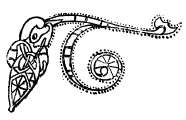
SECTION V.
Oaths in Ancient Ireland

HERE does not appear to have been at any time in ancient Ireland one fixed form of oath or manner of swearing in legal proceedings. The Brehon Laws do not tell us much of how our pagan fathers swore. There is no doubt at all that they did swear; and, if writings not of a legal character are to be trusted, they swore on solemn occasions by the sun, moon, wind, and other elements, the dew, the crops, and the countenances of men. Ugaine Mor, before his death in a.m. 4606, "exacted oaths, by all the elements visible and invisible, from the men of Erinn in general that they would never contend for the sovereignty of Erinn with his children or his race" (Four Masters). In Christian times a similar variety of oaths prevailed, all differing in legal value. The oath of highest value was that taken on the Gospels; but an oath taken on a relic, on a shrine or reliquary, or on a bishop's crosier, was also deemed very solemn and binding. Again, the value of the oath differed according to the place in which it was taken. Sometimes it was taken in the house of the person swearing, sometimes at the grave of those dearest to him, sometimes in a court of justice, sometimes in a church before the altar. That at the grave was probably of pagan origin. In some cases the oath was not a simple oath, but a triple one; the person swore first standing, then sitting, and then lying, as he spent his life.
"The king excells all in testimony, for he can, by his mere word, decide against every class of persons, except those of the two orders of religion and learning who are of equal rank with him." This is still generally so in monarchies.

